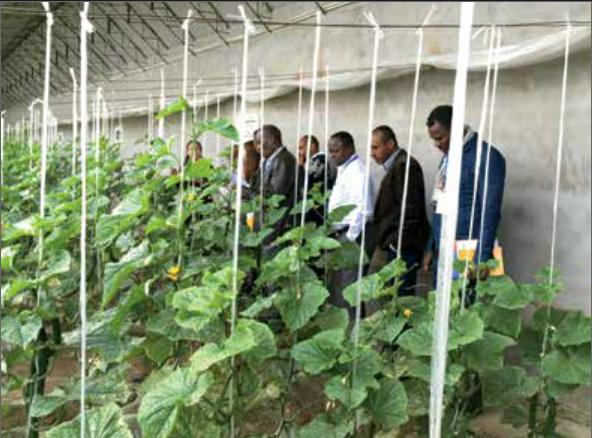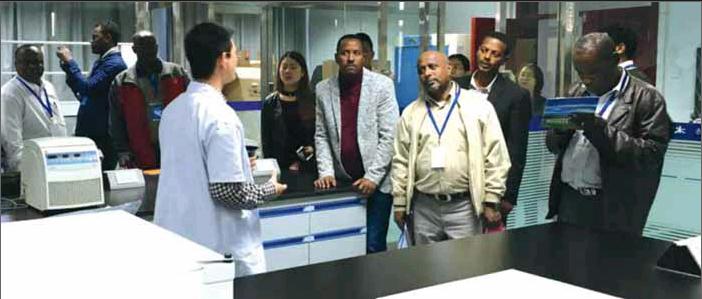Hands-on Training
By+Li+Xiaoyu


After watching a steady stream of chinese instructors visit his college to share advanced agricultural technology and teaching methods, Tamirat Tesema Senbeta was keen to witness firsthand how these instructors operate in their own country.
Tamirat, Dean of the Agarfa Agricultural Technical Vocational and Educational Training (ATVET) College in Ethiopia, got the opportunity this April as part of a 10-person delegation of Ethiopian ATVET deans and state agricultural officials, invited to attend a training program organized by the Chinese Ministry of Agriculture.
During the 12-day program, the visitors learned about agricultural development in China, and traveled to Beijing, the Inner Mongolia Autonomous Region and Sichuan Province to learn about Chinese curriculum design and college management. They also visited the farm of China Mengniu Dairy Co. Ltd., one of Chinas leading dairy producers, as well as Dujiangyan Water Conservancy Project built in ancient China.
To date, 90 Ethiopian ATVET deans and agricultural officials have attended similar training programs in China. “We hope the training program will share some of Chinas agricultural vocational education experience with our Ethiopian counterparts,” said Lin Huifang, Deputy Director of the Center of International Cooperation Service, Ministry of Agriculture (MOA).
Teaching practical skills
In 2009, 45-year-old Hu Zuobin, a senior veterinarian from Sichuan, first went to Ethiopia as part of an agricultural education cooperation program between China and Ethiopia organized by the MOA. His job was to teach veterinary clinical diagnosis at the Alage ATVET College south of Addis Ababa.
Whilst there Hu realized that the Ethiopian veterinary teachers had not received enough practical training themselves. They were therefore not experienced enough to give demonstrations to their students. As a result, the students, who would become vets one day, lacked practical skills.
Given this, Hu gave students practical demonstrations of key clinical skills such as giving intravenous transfusions and taking blood samples.
“We observed and analyzed the colleges needs and problems so that we could address them accordingly,” Hu said. “Thats how we built trust.”
By July, 2016, Hu had attended five sessions of the China-Ethiopia ATVET program. His efforts to introduce practical training in class were lauded by both the students and college administrators.
He is just one of the many Chinese agricultural experts in the program who are dedicated to making creative contributions in Ethiopian vocational schools.
After signing an agreement in 2001, China sent the first batch of 10 Chinese teachers to Ethiopia the same year. Since then, 425 Chinese teachers like Hu have gone to Ethiopia to provide guidance and training to around 2,100 Ethiopian teachers, over 13,000 agricultural technicians and more than 39,000 students.
“This year, we have nine Chinese teachers in our college. They have been teaching specific and different skills in several disciplines,” Kebede Beyecha Gemechu, Dean of the Alage ATVET College told ChinAfrica. “They have the capacity to transfer agricultural technologies through practical demonstrations.”
According to the teaching plan of Ethiopias ATVET colleges, practical training should account for 70 percent of the curriculum. “But in reality, we have more theoretical lessons than practical ones, so we should learn from Chinas experience to include a more practical curriculum,” said Kebede Atsebi Bizani, Training and Advisory Director of Ethiopias Ministry of Agriculture.
“Currently, there are 20 Chinese teachers working in Ethiopia. We hope they can give both practical training and theoretical lectures for our teachers and students,” he added.
Advance technologies
Temertu Sahlu Hailemariam, Vice Dean of the Alage ATVET College in charge of affairs related to technology transfer, is more interested in Chinas policy in agricultural technology development and transfer.
“It is the policy that makes agricultural technology development and transfer fruitful. Actually, we need not only the knowledge, but also the skills to develop agricultural technologies and to transfer them to farmers, because agriculture is the basis of Ethiopias economy,” he said.
Temertu believes Chinese agricultural technologies are very important to Ethiopia. Not only are 80 percent of Ethiopias population reliant on agriculture, but agriculture contributes 46 percent of the countrys GDP, and agricultural products account for 80 to 90 percent of export earnings, he said.
Introducing practical agricultural technologies to Ethiopia has always been one of the priorities of Chinese teachers. So far, they have introduced more than 70 advanced technologies widely used in China, including collecting rainwater, building greenhouses for growing vegetables and fish ponds, according to Lin.
In addition, they have also come up with many innovations. They have made a user-friendly corn planting machine, built Ethiopias first artificial insemination laboratory for breeding pigs, and established an expert diagnostic system for epidemics.
“There is not only practical training for students. We have also invited farmers from the surrounding areas. We expect these Chinese instructors to bring new technologies. A lot of courses have helped solve community agricultural problems,” said Tamirat.
The Chinese teachers have also worked with their local peers to compile textbooks for ATVET students. So far, six have been compiled, addressing the shortage of good textbooks in the colleges.
The agricultural educational personnel exchange program between Ethiopia and China is very important, said Genet Teshome Jirru, Deputy Head of Mission of the Ethiopian Embassy in China.
“It would definitely enhance Ethiopian research and development capacity building in the agricultural sector, and further deepen the relationship between our two countries,” he said.

